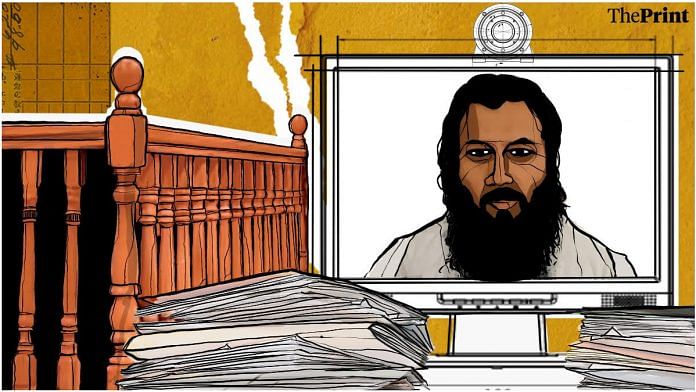Pune: Nadia Macerini left the United States after the 9/11 terrorist attacks in 2001 and moved to ‘Poona’ in search of peace, only to lose her life nine years later in 2010, to 13/2 — another terrorist attack thousands of miles and the proverbial seven seas away in India. Nadia, who became Nandini in India, and 16 others like her, died in the blast at Pune’s German Bakery twelve years ago.
The hunt for those responsible is a tale of two trials that represents the state of India’s broken criminal justice system.
The trial against one of the accused, Yasin Bhatkal, didn’t begin until June this year–eight years after he was arrested in 2014. Judicial records show that the prosecution couldn’t produce him before the court for almost 100 hearings, citing reasons ranging from security concerns in transporting the accused from Delhi’s Tihar jail to Pune, to the spending of public funds in his travel and non-availability of train tickets, and lack of technical infrastructure to connect him through video conferencing from Tihar. It was finally Covid that seems to have given a new life to the trial, after courts and jails across the country made advancements to their technological infrastructure during the lockdown.
Another trial that began in the case dates back to 2010—the year of the blast. This is against Mirza Himayat Baig, who has spent a large portion of the last five years in an anda cell despite the Bombay High Court setting aside the terror charges against him. The high court awarded him life term for possessing explosives, and appeals against the high court judgment are pending in the Supreme Court. However, larger and more pertinent questions relating to his participation and role in the 2010 blast remain unanswered.
The bakery came up 500 metres away from Pune’s Osho Ashram in 1989, soon after the Rajneesh Movement fled the US authorities, and returned to its headquarters in this Maharashtra city. The idea for the bakery was conceived right outside the Ashram, where the world of its co-founders – the cigarette seller Dyaneshwar Kharose, and the German Klaus Woody Gutzeit – collided. As ironic as it sounds, the duo started the bakery for people like Nadia—the travellers, the backpackers, the foreigners exploring different cultures.
On a tragic Saturday evening in 2010, a day before the Valentine’s Day, the bomb blast ripped through the bakery, blowing its fiber sheet roof to pieces, and forcing its walls to cave in.
The owners of the bakery managed to reopen the iconic spot three years later but for some, the place is just not the same anymore — the old croissant logo gave way to an owl perched on top of a croissant; a metal detector permanently placed at the entrance, and communal tables replaced with white wrought-iron chairs and a more private seating arrangement with tables for twos, threes and fours. According to Dyaneshwar’s daughter, Snehal Kharose, they chose to upgrade the logo with an owl, “because owl happens to be the lucky mascot of Germans..to show that we are “upgrading, from the old to the new”.
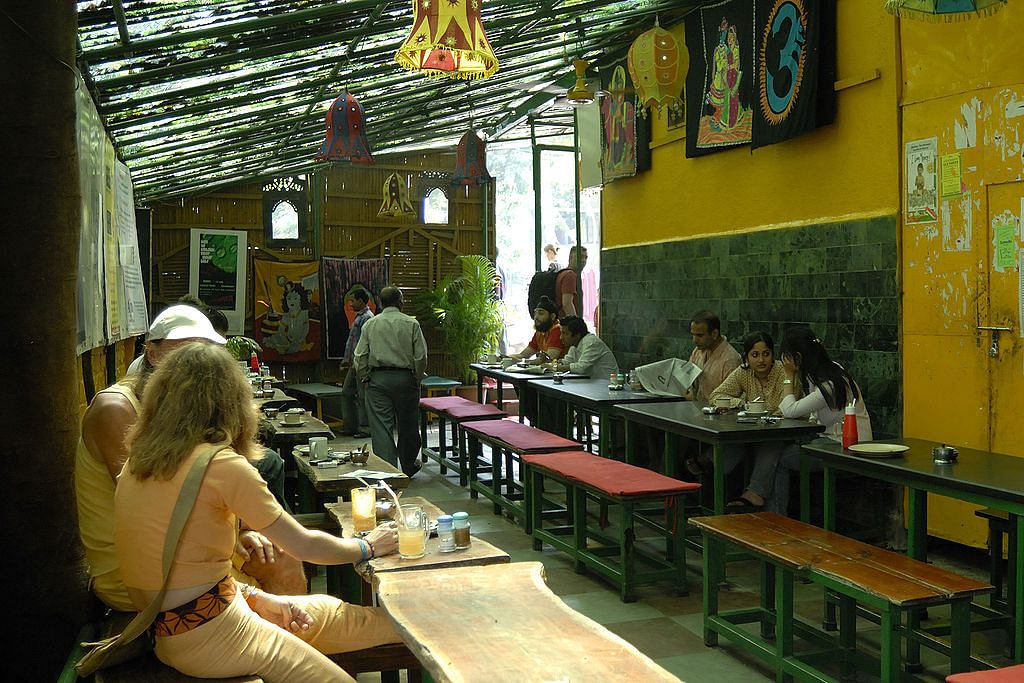
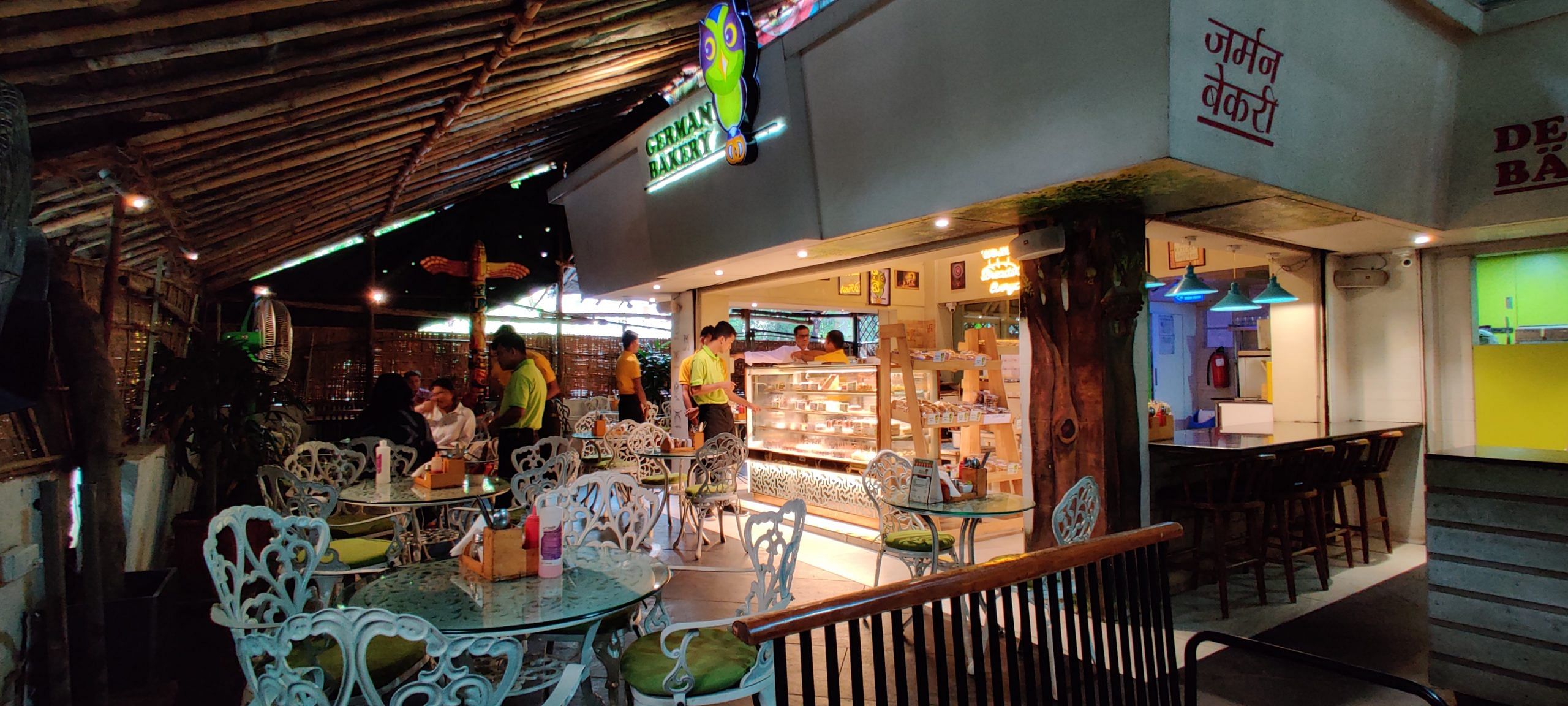
Also read: MCOCA, conflicting evidence, 44,000 pages of confusion — 7/11 train bombing case drags
The man in the cap
The first big breakthrough in the case came for Pune police when a grainy CCTV footage caught a ‘man in a cap’ — as he was referred to during the police probe, in judicial records and newspaper articles — with two bags entering the Bakery. The image was retrieved from CCTV footage both at the bakery as well as the neighbouring ‘O’ Hotel. The police claim this man to be Mohammed Ahmed Siddibappa Mohammed Zarar aka Ahmed aka Imran aka Shivanand aka Yasin Bhatkal, the co-founder of the Indian Mujahideen (IM) terror group.
Bhatkal was arrested in August 2013 from Bihar’s Raxaul town bordering Nepal. At the time, he topped the Delhi Police’s list of 15 most wanted terrorists involved in bombings across the country — including Hyderabad, Bangalore, Pune and Bodh Gaya — between November 2007 and July 2013.
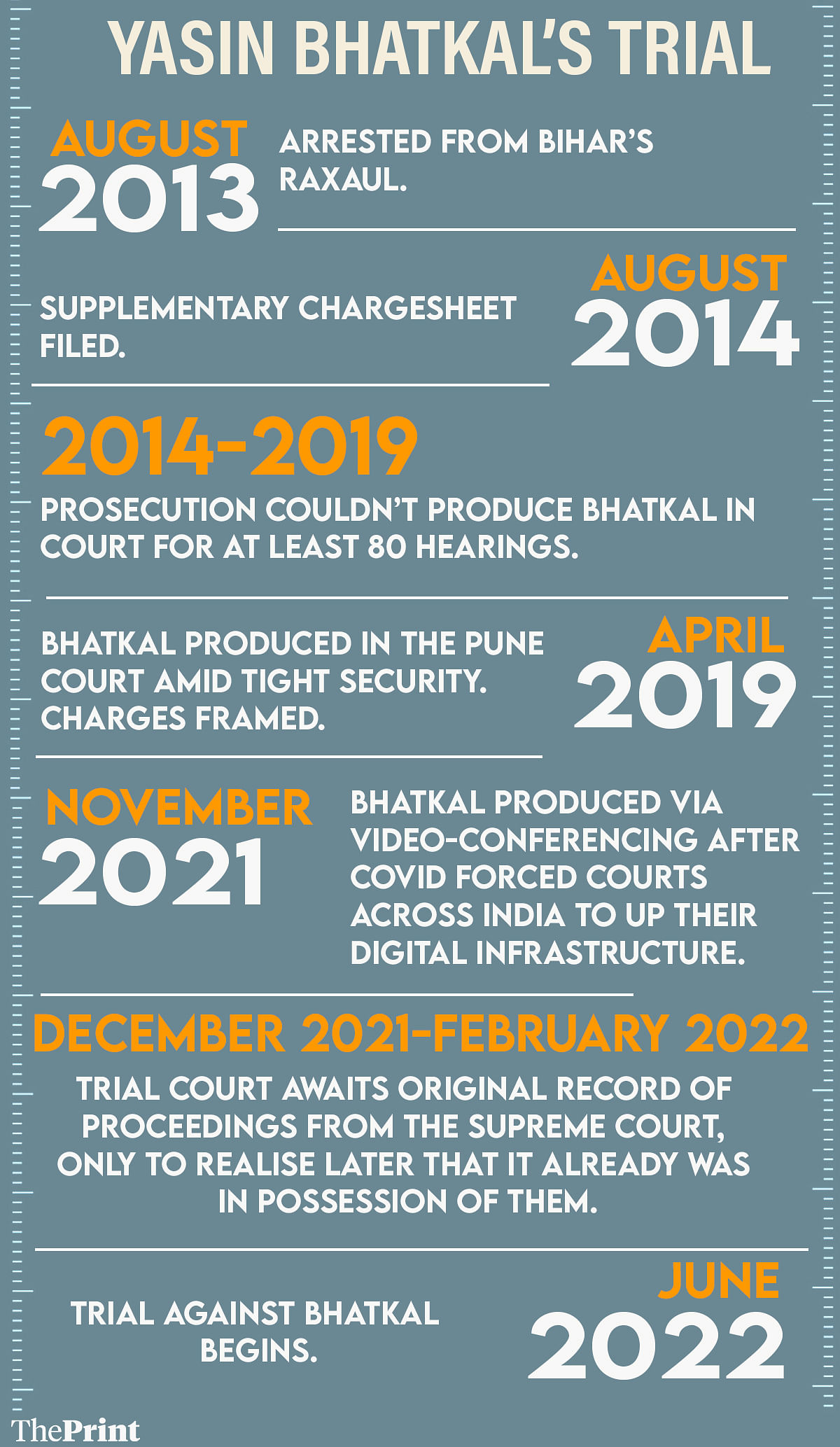
A supplementary chargesheet was filed against him for the German Bakery blast in August 2014. It is at this stage of the judicial proceedings that the presence of the accused is necessary for charges to be framed. After the charge is framed, the court is supposed to read and explain the same to the accused, and ask him/her whether he admits or denies them. This is where the case remained stuck for the next five years.
Charges could be framed against Bhatkal only on 29 April 2019. Up until then, court records presented a wild goose-chase for him, despite him being in custody at Delhi’s Tihar Jail. Handwritten court records accessed by ThePrint show that several unsuccessful attempts were made to get Bhatkal appear before the court through video-conferencing (VC).
One such record from as early as August 2014 says that “due to problem in telephone lines of the court, the VC facility is not functioning and therefore, (the court) cannot connect to Tihar jail”. Records from 28 October 2014 say, “It is informed by the office of this court that the video conferencing facility is not functioning due to technical problem and so Tihar jail cannot be linked”. In fact, records from 2014 to 2019 take note of the same issue, in one form or another. At least 13 records between December 2014 to June 2015 say that “Tihar jail be informed the next date of the case so that the presence of accused will be taken through video conferencing”.
In 2018, the Pune district court also issued several production warrants for Bhatkal to be produced before it. However, in response, in December that year, the court was told by jail and police authorities that Bhatkal cannot be produced “due to shortage of time and non-availability of confirmed train tickets” for the staff members accompanying the accused. By September 2018, when a bail application was filed for Bhatkal, the court was informed that the prosecution had already “miserably failed” to produce him before the court on 71 occasions. Then, in early 2019, the court was told that Bhatkal needs to be produced before Delhi’s Patiala House Court in relation to another case against him and can, therefore, not be produced before the Pune court.
After a wait of almost five years since the chargesheet was filed, Bhatkal was physically produced at the Pune court on 29 April 2019, and charges framed against him. He has been charged with Sections 302, 307, 326, 325, 324, 427, 120 (b), 467, 468, 474, 153 (a), 109 and 34 of the Indian Penal Code, along with provisions of the Explosives Substances Act and the Unlawful Activities (Prevention) Act. He pleaded “not guilty” to all of them.
Also read: Shahid Azmi fought for wrongly accused all life. His own murder case let down by Jamiat, court
A Covid-induced trial
Yasin Bhatkal was brought from Delhi’s Tihar Jail to Pune by a team of Delhi police on 29 April 2019 amid tight security and blistering heat wave. A lawyer based in Pune explains that the security arrangement turned the entire Pune district court complex into “a fortress” as Bhatkal was produced before special judge K.D. Vadane around 11:30am.
After charges were framed against the IM operative, on the same day, the Anti-Terrorism Squad of Maharashtra Police filed an application before the Pune court, demanding that Bhatkal be allowed to be produced through video conferencing for the trial. The ATS application called Bhatkal a “very very high risk prisoner”, and complained about the “manpower (local police and special forces) and public funds” that were spent in bringing him to Pune. Additionally, the application also said that there was “every apprehension of his own terrorist group or his anti-group or any other fundamentalist attacking him”. The application had to be filed because, as a general rule, trial should be conducted in the presence of the accused.
The court allowed this application on 16 September 2019. When the stage was finally set for Bhatkal to be officially produced before the Pune court via video conferencing, Covid struck, leading to a nationwide lockdown. The next two years saw little progress in the case.
Since September 2019, the case has come up for hearing 59 times. However, the first such order since September 2019 that notes Bhatkal’s presence through video conferencing was on 24 November 2021, after the trial court issued a letter to the Superintendent of Tihar jail to make arrangements during the previous hearing on 10 November 2021. This was after the case came up at least 30 times during the two-year period.
A lawyer associated with the case told ThePrint that Covid provided the final push for Bhatkal to be produced more regularly before the Pune court via video conferencing. District courts have heard more than 1 crore cases through video conferencing since the onset of the pandemic.
Also read: Can judiciary stand up to all-powerful executive? How judges did it during Emergency
Another mix-up
However, just when things started to look up in Bhatkal’s trial, with Covid numbers going down, there was another mix-up that contributed to a delay of at least two more months.
On 8 December 2021, the trial court noted that the trial could not begin because the original record of the proceedings was sent to the Supreme Court, which was hearing the appeal in Baig’s case. The trial court order, seen by ThePrint, says that “the prosecution has shown inability to proceed with the trial unless and until the record and proceedings is received by the court”. So, the court went ahead and issued a request letter to the Registrar of the Supreme Court to send records of the case to the trial court through the Registrar of the Bombay High Court.
And then the court waited, with bated breath, for two months, for the original record. The matter was adjourned twice, on 25 January and 3 February this year, after the court noted that the record had not been received yet.
However, some time in February this year, the court realised, rather embarrassingly, that it already had the original record with it. Apologising for the mix-up, court records noted that since the case against Bhatkal was registered under a new case number– Special Case ATS No. 1 of 2014– different from Baig’s– Sessions Case No. 771 of 2010– the court hadn’t realised that the original record had already been returned to it.
The trial in the case finally began in June this year. It has come up eight times since then, with the evidence of different witnesses being heard. The Pune courtroom now has a computer perched atop a table, near a pile of files next to the witness stand, arranged at an angle that ensures witnesses and the lawyers are able see Bhatkal peering through the screen.
Also read: ED, Gujarat, UAPA, Central Vista: Justice Khanwilkar’s 6-year ‘establishmentarian’ legacy at SC
‘I am in a thousand chains’
While ATS claims that Bhatkal was the one who planted the bomb in the bakery, it was another man–Mirza Himayat Baig–who allegedly helped the IM operative assemble the bomb at his ‘Global Internet Cafe’ at Urgir, in Maharashtra’s Latur district. According to the ATS, Baig also then accompanied Bhatkal to Pune with the bomb.
Baig was first produced before the Pune court on 8 September 2010. The chargesheet was filed against seven people – Baig and six others, including Bhatkal, who were shown as absconding. The prosecution had alleged that Baig was a member of the banned terrorist organisation Lashkar-E-Taiba (LeT).
Baig’s trial began in December 2010 and went on for two years, four months and eight days. In a 278-page judgment delivered in April 2013, Additional Sessions Judge N.P. Dhote gave Baig five death sentences and several life terms for the crime.
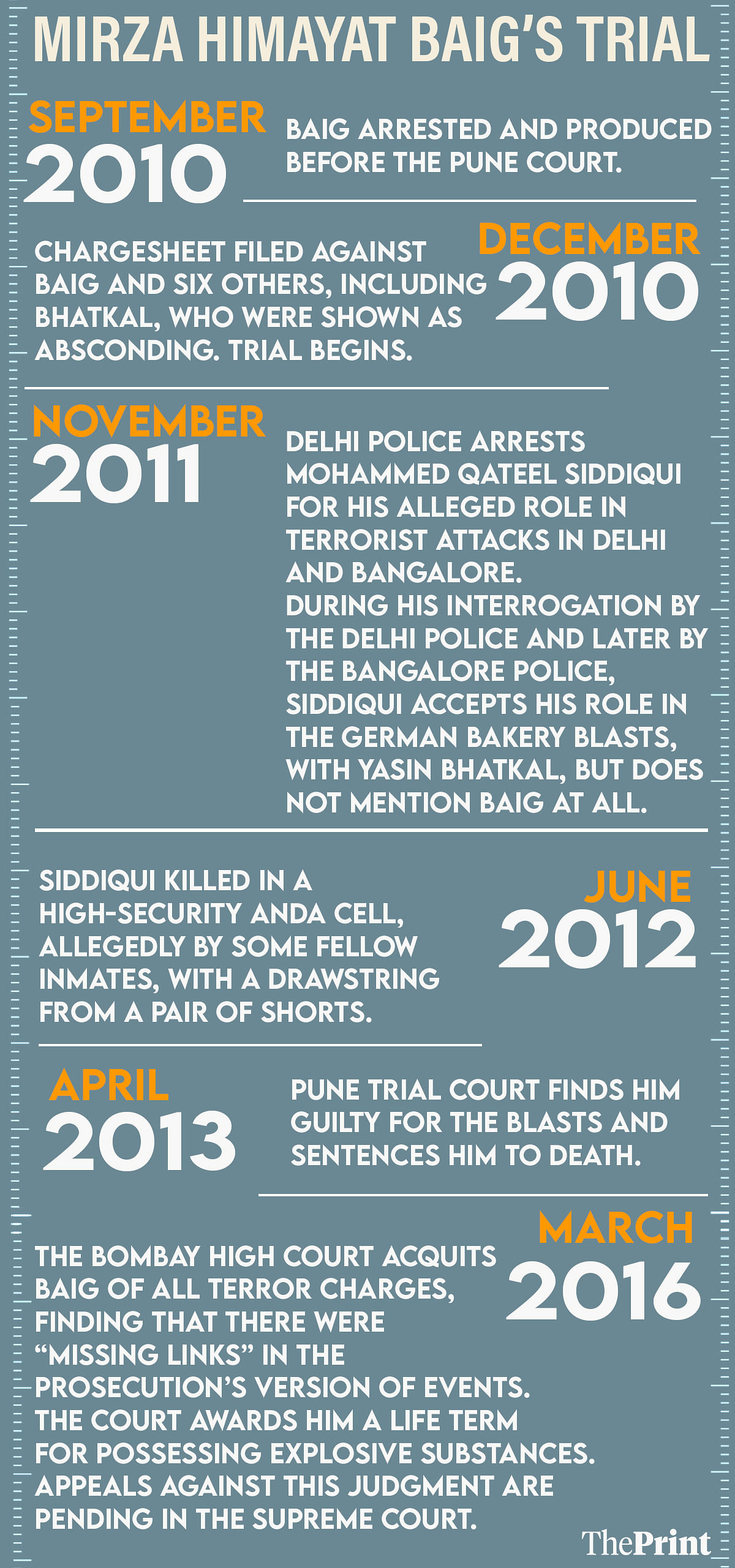
However, in March 2016, the Bombay High Court acquitted Baig of all terror charges and only convicted him for possessing a “blackish substance”, which was found to be RDX, and for possessing forged documents, including a handicap certificate, caste certificate, ration card and domicile certificate. The court found that there were “missing links” in the prosecution’s version of events, and said, in no uncertain terms, that “there is no evidence connecting the accused with the activities of preparing of the bomb and helping the other accused to use it for achieving the object of creation of terror in the section of people of India”.
Appeals filed by Baig as well as the government challenging the high court judgment are currently pending in the Supreme Court. However, despite his acquittal of terror charges, Baig has reportedly been lodged in an anda cell for most part of the last six years.
As a death row convict, Baig was lodged in the Faansi Yard of the Nagpur Central Jail. In May 2016, his brother complained that even after the high court judgment acquitted him of terror charges, he continued to be in the barracks reserved for prisoners soon to be hanged, isolated from other prisoners. He was moved to Nashik Central Jail only in July 2016. However, according to a letter written by Baig to jail authorities in November 2020, he spent the next five years in an anda cell. In another letter written to his childhood friend in September 2019, he wrote, “Main yahan par hazaron bandishon mein hoon (I’m in a thousand chains here).”
Also read: Who was Jane Roe of Roe v Wade? What overturning of the 1973 judgment means for American women
A drawstring from a pair of shorts
The ATS claims to have identified Bhatkal as the man wearing a cap, carrying a rucksack, and entering the bakery, to plant the bomb, as Macerini and several others around her were enjoying their meal on a pleasant Saturday evening. But who was with Bhatkal on 13 February 2010 in Pune? The answer depends on who you ask.
The ATS has claimed that Bhatkal was with Baig. The investigating agency had relied on the testimony of an autorickshaw driver, who went to the ATS office on 27 May 2010, claiming that he had dropped Bhatkal and Baig from Pune’s railway station to the city’s Central Mall. A photograph of this man in a cap published in the newspaper apparently jogged his memory, after which he offered himself at the ATS office. However, the Bombay High Court rejected the autorickshaw driver’s testimony, asserting that “his evidence does not inspire confidence”.
But if you ask the Delhi Police Special Cell, they might have a different answer– they might say it was Mohammed Qateel Siddiqui and not Baig. In November 2011, the Delhi Police arrested Siddiqui for his alleged role in the 2010 Chinnaswamy Stadium Bangalore blasts and the 2010 Jama Masjid attack in Delhi. During his interrogation by the Delhi Police and later by the Bangalore police, Siddiqui reportedly accepted his role in the German Bakery blasts, with Yasin Bhatkal, but did not mention Baig at all.
Advocate Mehmood Pracha, who represented Baig in the Bombay High Court, had also demanded a reinvestigation into Baig’s role in the blasts. Pracha still holds on to his stand, saying he believes that the CCTV footage produced as evidence against Baig was “doctored”.
In 2013, reports had also claimed that Bhatkal had admitted responsibility for the German Bakery blasts before the investigating agencies, but had named Mohammed Qateel Siddiqui as his fellow-conspirator.
However, like all good whodunnits, there was a major twist that shut several leads for those who believe in the innocence of Baig. In June 2012, Siddiqui was killed in a high-security anda cell, allegedly by some fellow inmates, with a drawstring from a pair of shorts. This was ten days after he was sent to Yerawada jail after a Pune court remanded him to judicial custody till 8 June. He was murdered on the day his judicial custody was to end.
His family cried foul almost immediately and demanded a CBI probe into the murder. His then eight-month pregnant wife, Fatima, alleged that the ATS and the Intelligence Bureau killed her husband in prison to cover up their mistakes. She even filed a petition in the Bombay High Court, demanding an impartial probe by a central agency or a court-appointed Special Investigating Team. However, this petition has remained pending at the high court since June 2013.
Also read: Mohd Zubair got bail, but the guiding principle of India’s justice system is still in jail
‘It’s just not the same’
With its long communal tables, freshly baked bread, a manual espresso machine and a cacophony of foreign languages, the German Bakery before the blast was a picture of a world without borders–nestling its hippie vibe safely in the corner of a street, in the heart of an otherwise pensioner’s paradise, Pune. It took three years for Dyaneshwar’s 19-year-old daughter, Snehal Kharose, to get the place up and running again, on 13 February 2013 — on the third anniversary of the blast.
While she was skeptical that people might be scared to come back, she was happy to be proven wrong.
“To be honest, people were really supportive. In fact, when the place was in the construction phase, people would come up and ask when the bakery would start again,” she recalls.
She does accept that the vibe of the bakery is completely different now, but blames it on the “changing times”.
“We had a whole Goa shack vibe earlier…I do think we didn’t do justice to the previous one, it is completely different now, we’ve changed the vibe, the whole ambience…But this was on the cards even before the blast,” she told ThePrint, adding, “It is still people’s favorite,” gesturing towards the crowd thronging the bakery on a Monday morning. In the lanes of Koregaon Park, she still gets recognised as “Nanu’s daughter”. However, these lanes do not have Nadia cycling through them on her pink bicycle anymore.
“She was so tiny, her feet barely touched the paddles of the bike,” says Eshana Meyer, Nadia’s friend from the Osho Ashram, enacting Nadia climbing onto a bicycle, both feet hanging inches above the ground.
Her friends now have a Facebook page dedicated to Nadia, with a description of the group translating to: ‘We remember you in your search for universal truth and earthly peace.’ A letter from January 2008 showed that Nadia was full of hope for her future. She wrote to a friend two years before the blast and spoke about how she was now making it her “greatest purpose this year” to find “stability”. She was determined to “design a beautiful old school fairytale, revisit it with modern details”, and be in it as “the main character”.
Thirty-seven-year-old Nadia took her last journey from Pune to Italy almost a week after the blast. Meyer was also tasked with buying clothes for Nadia’s final trip back home to Italy in a coffin. Eshana says she bought Nadia “a darling pink dress”. She also bought her a “gray cashmere sweater”.
“Because Nadia always got so cold,” she says.
(Edited by Anurag Chaubey)


